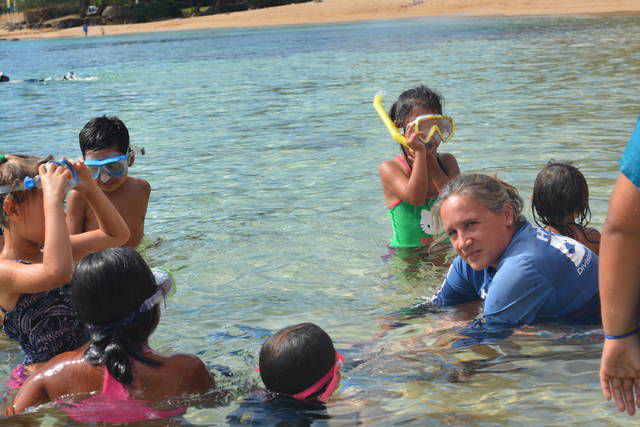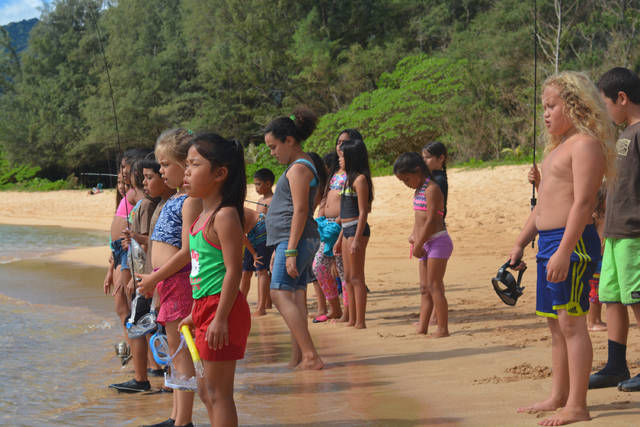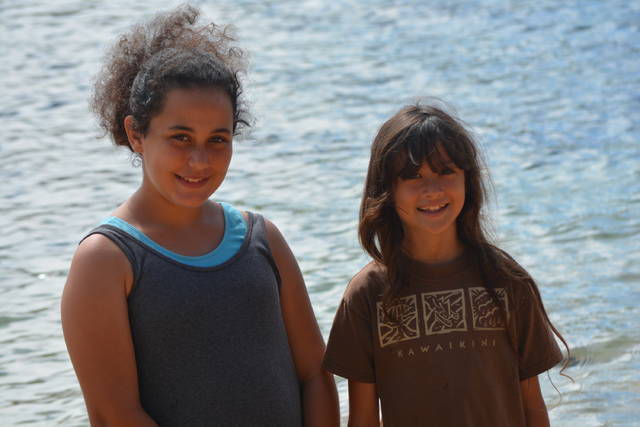This is the first in a series that investigates the story of the coral reefs, worldwide and around Kauai. Look for upcoming articles on the factors that impact the reefs, cutting-edge technologies to help them adapt, and what one man
This is the first in a series that investigates the story of the coral reefs, worldwide and around Kauai. Look for upcoming articles on the factors that impact the reefs, cutting-edge technologies to help them adapt, and what one man says is a glimmer of hope in a damaged reef at Waipa on Kauai’s North Shore.
MOLOAA — A dozen schoolchildren stood at the edge of Moloaa Bay during a recent field trip. Before entering the water to study the coral, they performed an oli, or a traditional Hawaiian chant.
It was the first segment of the Kumulipu, the Hawaiian Hymn of Creation, which tells the story of how life sprang from darkness — and how it all started with a coral polyp.
“For us as Hawaiians, the initial connection we have with coral is that it’s the first living thing in terms of our creation chant,” said Lei Wann, a kumu at Kawaikini New Century Public Charter School. “We always start off with that before we enter the ocean and study the different corals and polyps. For us it’s the reason why we’re here.”
After the oli, the third- and fourth-graders broke into two groups. One studied the corals in Moloaa Bay with Katie Nelesere, education and outreach coordinator for the state’s Department of Land and Natural Resources’ Division of Aquatic Resources. The other group searched for different kinds of limu, or seaweed, in the rocks.
“We’ve been out and done this at two other reefs with these kids,” Nelesere said. “We go out and study the coral and then go back to the classroom where they make clay models of what we saw.”
The goal is to teach the keiki about their environment through place-based learning.
“We’re super lucky as a school to still be able to do this,” Wann said. “Other schools can’t access the ocean like these kids can. They still can dive and look and see.”
One of the things that fourth-grader Kahiau Martinez said she’s been seeing a lot of is cauliflower coral.
“The last excursion … we went in the water and saw a cauliflower,” she said. “It was huge and it was green.”
In addition to being a cultural cornerstone, coral reefs are the home of 25 percent of fish in the ocean. They also create drag and surf, and contribute to the economy through tourism and fishing.
And within the last 30 years, roughly half of them worldwide have died, according to experts.
“The Aussies are saying that we’ve killed off the Great Barrier Reef and even if we stopped CO2 production today, it’s too late,” said Carl Berg, marine biologist on Kauai. “We’ve lost control of our acidity and temperature because of global climate change.”
A new report in the publication Nature points to rising sea temperatures as the cause for severe damage of the world’s largest reef.
Scientists have been monitoring bleaching events in the Great Barrier Reef since 1998.
In 2016, 1,052 of the 1,156 reefs checked experienced some sort of bleaching.
That’s 9 percent of the reef that wasn’t damaged in 2016. In 1998, 45 percent of the reefs weren’t bleached.
Both 1998 and 2016 were El Nino years, meaning warmer water naturally moves across the ocean, causing a variation in temperatures. But scientists say the events are now happening more frequently.
“Corals are used to natural fluctuation, but when it happens every few years, the reefs can’t recover,” said Curt Storlazzi, research geologist with the U.S. Geological Survey Pacific Coastal and Marine Science Center.
Kauai experienced severe coral bleaching and mortality in the 2014 and 2015 bleaching events, especially on the North Shore, as well as an epidemic of black band disease around the same time.
Scientists around the world say while it’s important to address the symptoms of the dying reefs, the focus should be on stopping the cause, which they say is CO2 emissions.
Some suggestions are to do things that decrease individual carbon footprings, lke avoiding single-use plastics and to find alternatives to driving.
“Instead of using plastic, use clay, those kinds of things,” said Katherine Muzik, a Kauai marine biologist.
Finding ways to shrink human impacts to the environment is also important, she said.
“There’s this concept called de-growth,” Muzik said. “We need to stop the trajectory of growth.”
Without coral reefs, life on Kauai would be different, said Martinez and her friend Anela Quintero, who is also in the fourth-grade at Kawaikini Charter School.
“We learned that the corals were the first things made and that without them the fish would have nowhere to live,” Quintero said. “And that if there’s no more coral then the waves’ll get bigger because the coral breaks down the wave.”




